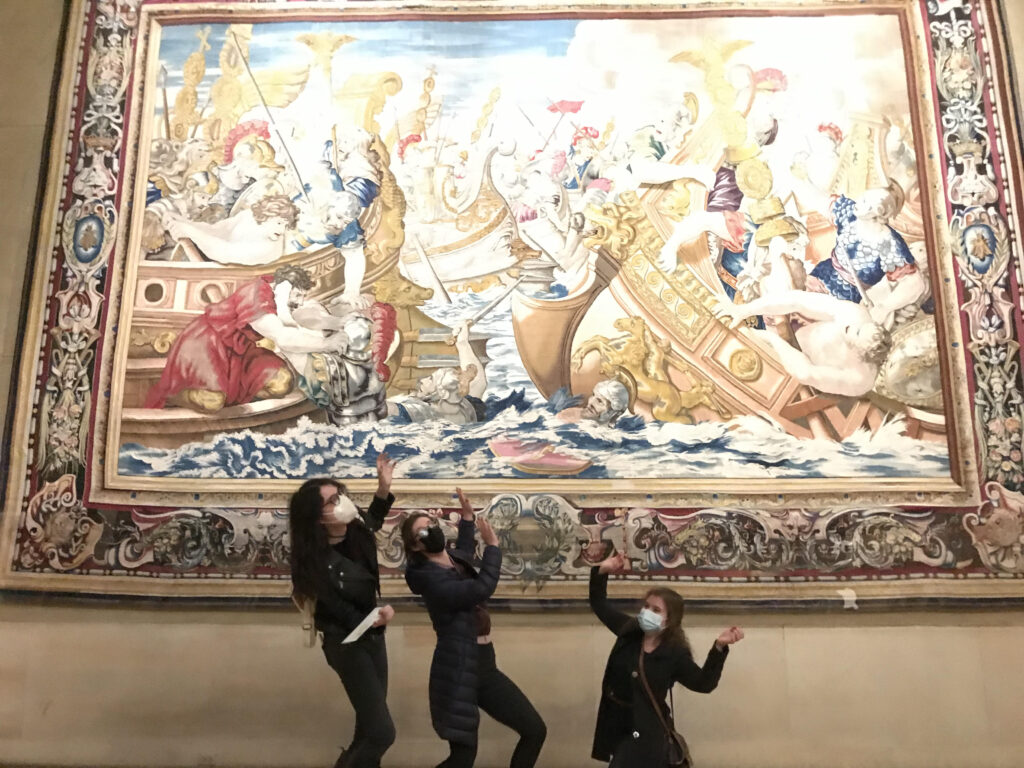2/28/2022 – The Continuing Cultural Relevance of Rome in the PMA
A few weeks ago we (Anna, Kai-Ling, Kate, and a friend from outside this class) went to the Philadelphia Museum of Art (PMA), and viewed several pieces depicting Roman events. While much of the art at the museum is from later periods of history, there were some wonderful tapestries showing various scenes in the life of Constantine. These tapestries were both instructive in Roman history and acted as examples of the beauty and intricacy of tapestry as an art form. We also saw one of the museum’s most striking pieces, a golden statue of the Roman goddess Diana prominently displayed at the top of a central staircase.
We found the central placement of these artworks to be interesting: while many of the museum’s collections are concerned with later periods of history, the first pieces visitors will see are Roman in content. The placement of these artworks thus demonstrates Rome’s continued relevance in our institutions of art and culture. While this statue was created for a multi-story building in the 1930’s, we found it remarkable that a Roman deity maintains the literally high cultural placement she might have enjoyed in Ancient Rome so many years and miles away. The statue, having been removed from its placement in the Philadelphia skyline,now resides at the top of the Museums’ central hall and staircase, positioning her again as the deity in a sort of temple and certainly the focal point of the Museum’s most notable indoor space. Even the museum itself resembles a classical temple, though not specifically Roman, its architecture reinforces the primacy of the classical world in modern cultural thought. Likewise, the creation of the pieces itself brought to mind the fact that Rome was similarly seen as relevant in the time of the pieces’ creation, and that Rome has resonated throughout the past as well as in our present.
The friend who accompanied us had studied abroad in Rome, and was also able to remark on his experiences in modern-day Rome in contrast to our learning about ancient Rome. While he was able to see evidence of the continued presence of ancient Roman events and culture in both modern-day Rome and the PMA, he also commented on differences, and we were confronted by how much has been changed and lost across the centuries.
We were also inspired by the tapestries to think on textile work as an art form. Most textile work has traditionally been done by women: even in Roman theology it is Minerva, a goddess, who originated and oversaw tapestry work. Art forms typically undertaken by women have often been denigrated, but it is clear from the scale and detail in the PMA tapestries that such work required great skill and thousands of hours of painstaking work. Interestingly, while likely made exclusively by women, the tapestries depicted almost exclusively men (Constantine and his allies and enemies). Thus the tapestries acted almost as an allegory for broader conceptions of gender roles: the actions of “great men” made visible only through the painstaking labor of women who are themselves invisible and uncredited. Notably, many of these tapestries depicted the Roman armies in moments of great distress, highlighting their fallibility and suffering, rather than just the dramatic triumph or superhuman strength depictions of “great men” more often mythologize.
Overall, we were struck by art’s ability to connect us to the past, even the very distant past. Given the primary cultural importance of ancient Greece and Rome, we were surprised at the PMA’s lack of actual classical artifacts or even collections but rather the presence of artworks and artifacts that reflect Rome’s ongoing legacy. Viewing these tapestries and paintings prompted us to critically reflect on the ways in which these pieces were created, and how they have traveled through time and space to eventually be present in the museum with us.
Word Count: 639
